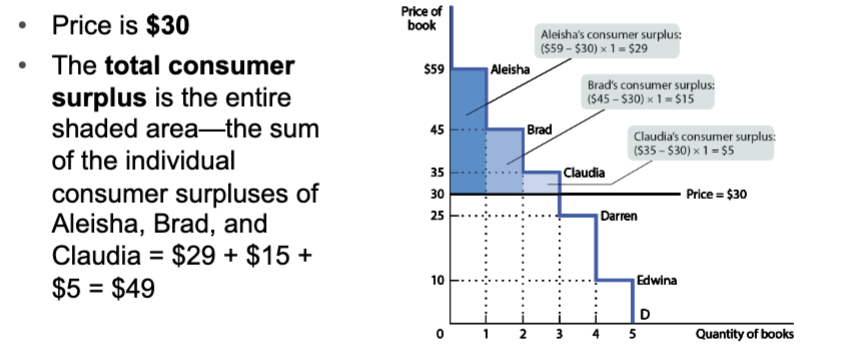Consumer and producer surplus - Chapter 4 - ECON100
1/24
There's no tags or description
Looks like no tags are added yet.
Name | Mastery | Learn | Test | Matching | Spaced |
|---|
No study sessions yet.
25 Terms
The analysis of consumer and producer surplus helps us calculate
How much benefit the producers and consumers receive
Consumer surplus
A consumers’ willingness to pay for a good at its maximum price which they would by that good
Individual consumer surplus
The gain to an individual buyer from the purchase of a good; the difference between the price paid vs. what the consumer is willing to pay
Total consumer surplus
The sum of individual consumer surpluses of all the buyers in a market

Producer surplus
The difference between market price and the price at which firms are willing to supply the product
Individual producer surplus
The net gain to an individual seller from selling a good. It. is equal to the difference between the price received and the seller’s cost (seller’s cost includes monetary cost and may also include opportunity cost
Total producer surplus
The sum of individual producer surpluses of all the sellers in the market
Total surplus
The sum of the producer and consumer surpluses
Price controls
Legal restrictions on how high or low a market price may go
two main types:
Price ceiling
Price floor
Price ceiling (price controls)
A maximum price sellers are allowed to charge for a good or service (usually set below equilibrium)
Price floor (price controls)
A minimum price buyers are required to pay for a good or service (usually set above equilibrium)
How price ceilings cause inefficiency
Inefficiently low quantity
Inefficient allocation to customers
Wasted resources
Inefficiently low quality
Black markets
Inefficient allocation to customers (How price ceilings cause inefficiency)
Price control leads to misallocation of apartments; people who badly need one might not get one. But some people who have them may have less urgent needs.
Under rent control, people get apartments through luck or personal connections.
Wasted resources (How price ceilings cause inefficiency)
People expend money, effort, and time to cope with shortages caused by price ceilings
The opportunity cost of the time spent in lines- the wages not earned- leisure time not enjoyed
Rent control creates missed opportunities
Inefficiently low quality (How price ceilings cause inefficiency)
At the controlled price, sellers have more customers than goods
In a free market, this would be an opportunity to profit by raising prices, but when prices are controlled, sellers cannot raise prices
Sellers respond in 2 ways: reduce quality, reduce service
Black market (How price ceilings cause inefficiency)
A market in which goods or services are bought and sold illegally
Why are there price ceilings
They do benefit some people: those who are more organized and vocal
If the price ceiling has been in effect for a long time, buyers may not have a realistic idea of what would happen without it
How a price floor causes inefficiency
Deadweight loss
Inefficient allocation of sales among sellers
Waste of resources
Inefficiently high quality
Temptation to break the law by selling below the legal price
Deadweight loss (how price floors cause inefficiency)
A price floor reduces the quantity demanded below the market equilibrium quantity and leads to a deadweight loss.
Price controls typically create this
Inefficient allocation of sales among sellers (how price floors cause inefficiency)
Price floors misallocate sales by:
• Allowing high-cost firms to operate.
• Preventing low-cost firms from entering the industry.
Wasted resources (How price floors cause inefficiency)
Price floors encourage waste
To deal with the surplus generated by dairy price floors, the government buys back the excess, donates it, or gets rid of it.
Inefficiently high quality (how price floors cause inefficiency)
Price floors encourage sellers to offer goods of inefficiently high quality—the quality that is higher than buyers are willing to pay for.
Illegal activity (how price floors cause inefficiency)
Price floors encourage black markets. There are willing sellers (and buyers) at illegal prices, so they are tempted to break the law and trade with each other.
Why are there price floors?
They do benefit some people (who are typically better organized and more vocal than those who are harmed by them).
Government officials often do not understand supply and demand analysis.
Price ceilings and floors typically
Change quantities along existing curves